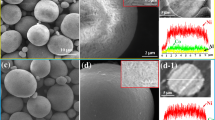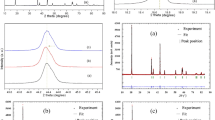Abstract
Ni-rich cathode materials have high specific capacity and low cost, but they also have several drawbacks, such as high pH and poor cycle stability. In this paper, a simple dry-coat method using MnCO3 was adopted to improve the performance of LiNi0.8Co0.15Al0.05O2 (NCA), which is the first report of its kind. The modified NCA showed a capacity of 193 mAh g− 1 and capacity retention of 98.9% at 1 °C rate after 100 cycles, compared to the corresponding values (195 mAh g− 1 and 94.0%) for the pristine NCA. The pH was reduced from 12.19 to 11.69. Moreover, the storage performance in air and thermal stability in the delithiated state were also improved.









Similar content being viewed by others
References
Sasaki T, Nonaka T, Oka H, Okuda C, Itou Y, Kondo Y, Takeuchi Y, Ukyo Y, Tatsumi K, Muto S (2009) Capacity-fading mechanisms of LiNiO2-based lithium-ion batteries. J Electrochem Soc 156:A289–A293
Kojima Y, Muto S, Tatsumi K, Kondo H, Oka H, Horibuchi K, Ukyo Y (2011) Degradation analysis of a Ni-based layered positive-electrode active material cycled at elevated temperatures studied by scanning transmission electron microscopy and electron energy-loss spectroscopy. J Power Sources 196:7721–7727
Watanabe S, Kinoshita M, Hosokawa T, Morigaki K, Nakura K (2014) Capacity fading of LiAlyNi1−x−yCoxO2 cathode for lithium-ion batteries during accelerated calendar and cycle life tests (effect of depth of discharge in charge-discharge cycling on the suppression of the micro-crack generation of LiAlyNi1−x−yCoxO2 particle). J Power Sources 260:50–56
Kleiner K, Melke J, Merz M, Jakes P, Nagel P (2015) Unraveling the degradation process of LiNi0.8Co0.15Al0.05O2 electrodes in commercial lithium ion batteries by electronic structure investigations. Acs Appl Mater Inter 7:19589–19600
Shizuka K, Kiyohara C, Shima K, Takeda Y (2007) Effect of CO2 on layered Li1+zNi1−x−yCox M yO2 (M = Al, Mn) cathode materials for lithium ion batteries. J Power Sources 166:233–238
Eom J, Kim MG, Cho J (2008) Storage characteristics of LiNi0.8 Co0.1+xMn0.1−xO2 (x = 0, 0.03, and 0.06) cathode materials for lithium batteries. J Electrochem Soc 155:A239–A245
Matsumoto K, Kuzuo R, Takeya K, Yamanaka A (1999) Effects of CO2 in air on Li deintercalation from LiNi1−x−yCoxAlyO2. J Power Sources 81:558–561
Zhang XY, Jiang WJ, Zhu XP, Mauger A, Qilu JCM (2011) Aging of LiNi1/3Mn1/3Co1/3O2 cathode material upon exposure to H2O. J Power Sources 196:5102–5108
Liu HS, Zhang ZR, Gong ZL, Yang Y (2004) Origin of deterioration for LiNiO2 cathode material during storage in air. Electrochem Solid State Lett 7:A190–A193
Liu HS, Yang Y, Zhang JJ (2006) Investigation and improvement on the storage property of LiNi0.8Co0.2O2 as a cathode material for lithium-ion batteries. J Power Sources 162:644–650
Moshtev R, Zlatilova P, Vasilev S, Bakalova I, Kozawa A (1999) Synthesis, XRD characterization and electrochemical performance of overlithiated LiNiO2. J Power Sources 81:434– 441
Park JH, Park JK, Lee JW (2016) Stability of LiNi0.6Mn0.2 Co0.2O2 as a cathode material for lithium-ion batteries against air and moisture. B Korean Chem Soc 37:344–348
Xunhui X, Zhixing W, Peng Y, Huajun G, Fengxiang W, Jiexi W, **nhai L (2013) Washing effects on electrochemical performance and storage characteristics of LiNi0.8Co0.1Mn0.1O2 as cathode material for lithium-ion batteries. J Power Sources 222:318– 325
Kim J, Hong YS, Ryu KS, Kim MG, Cho J (2006) Washing effect of a LiNi0.83Co0.15Al0.02O2 cathode in water. Electrochem Solid State Lett 9:A19–A23
Naushad (ed) (2012) Life cycle assessment of wastewater treatment. Massachusetts Institute of Technology, Boston
Sulz CH (1888) A treatise on beverages or the complete practical bottler. Dick & Fitzgerald Publishers, New York
Kim H, Lee K, Kim S, Kim Y (2016) Fluorination of free lithium residues on the surface of lithium nickel cobalt aluminum oxide cathode materials for lithium ion batteries. Mater Design 100:175–179
Ring RJ, Royston D (1973) A review of fluorine cells and fluorine production facilities. Australian Atomic Energy Commission
Manthiram A, Knight JC, Myung ST, Oh SM, Sun YK (2016) Nickel-rich and lithium-rich layered oxide cathodes: progress and perspectives. Adv Energy Mater 6:1501010
Cho Y, Oh P, Cho J (2013) A new type of protective surface layer for high-capacity Ni-based cathode materials: nanoscaled surface pillaring layer. Nano Lett 13:1145–1152
Huang B, Li XH, Wang ZX, Guo HJ, Shen L, Wang J (2014) A comprehensive study on electrochemical performance of Mn-surface-modified LiNi0.8Co0.15Al0.05O2 synthesized by an in situ oxidizing-coating method. J Power Sources 252:200– 207
Yang J, **a YY (2016) Suppressing the phase transition of the layered Ni-rich oxide cathode during high-voltage cycling by introducing low-content Li2MnO3. Acs Appl Mater Inter 8:1297–1308
Zhang HL, Li B, Wang J, Wu BH, Fu T, Zhao JB (2016) Effects of Li2MnO3 coating on the high-voltage electrochemical performance and stability of Ni-rich layer cathode materials for lithium-ion batteries. Rsc Adv 6:22625–22632
Cao CH, Zhang J, **e XH, **a BJ (2017) Composition, structure, and performance of Ni-based cathodes in lithium ion batteries. Ionics 23:1337–1356
Jo JH, Jo CH, Yashiro H, Kim SJ, Myung ST (2016) Re-heating effect of Ni-rich cathode material on structure and electrochemical properties. J Power Sources 313:1–8
Jung SK, Gwon H, Hong J, Park KY, Seo DH, Kim H, Hyun J, Yang W, Kang K (2013) Understanding the degradation mechanisms of LiNi0.5Co0.2Mn0.3O2 cathode material in lithium ion batteries. Adv Energy Mater 1300787
Ohzuku T, Ueda A, Nagayama M (1993) Electrochemistry and structural chemistry of LiNiO2 (R-3m) for 4 volt secondary lithium cells. J Electrochem Soc 140:1862–1870
Guilmard M, Croguennec L, Delmas C (2003) Thermal stability of lithium nickel oxide derivatives. Part II: LixNi0.70Co0.15Al0.15O2 and LixNi0.90Mn0.10O2 (x = 0.50 and 0.30). Comparison with LixNi1.02O2 and LixNi0.89Al0.16O2. Chem Mater 15:4484–4493
Funding
This work was financially supported by the National Key R&D program of China (2016YFB0100500).
Author information
Authors and Affiliations
Corresponding author
Additional information
Publisher’s note
Springer Nature remains neutral with regard to jurisdictional claims in published maps and institutional affiliations.
Rights and permissions
About this article
Cite this article
Cao, C., Zhang, J., **e, X. et al. A novel method for the modification of LiNi0.8Co0.15Al0.05O2 with high cycle stability and low pH. J Solid State Electrochem 23, 1351–1358 (2019). https://doi.org/10.1007/s10008-019-04216-6
Received:
Revised:
Accepted:
Published:
Issue Date:
DOI: https://doi.org/10.1007/s10008-019-04216-6




